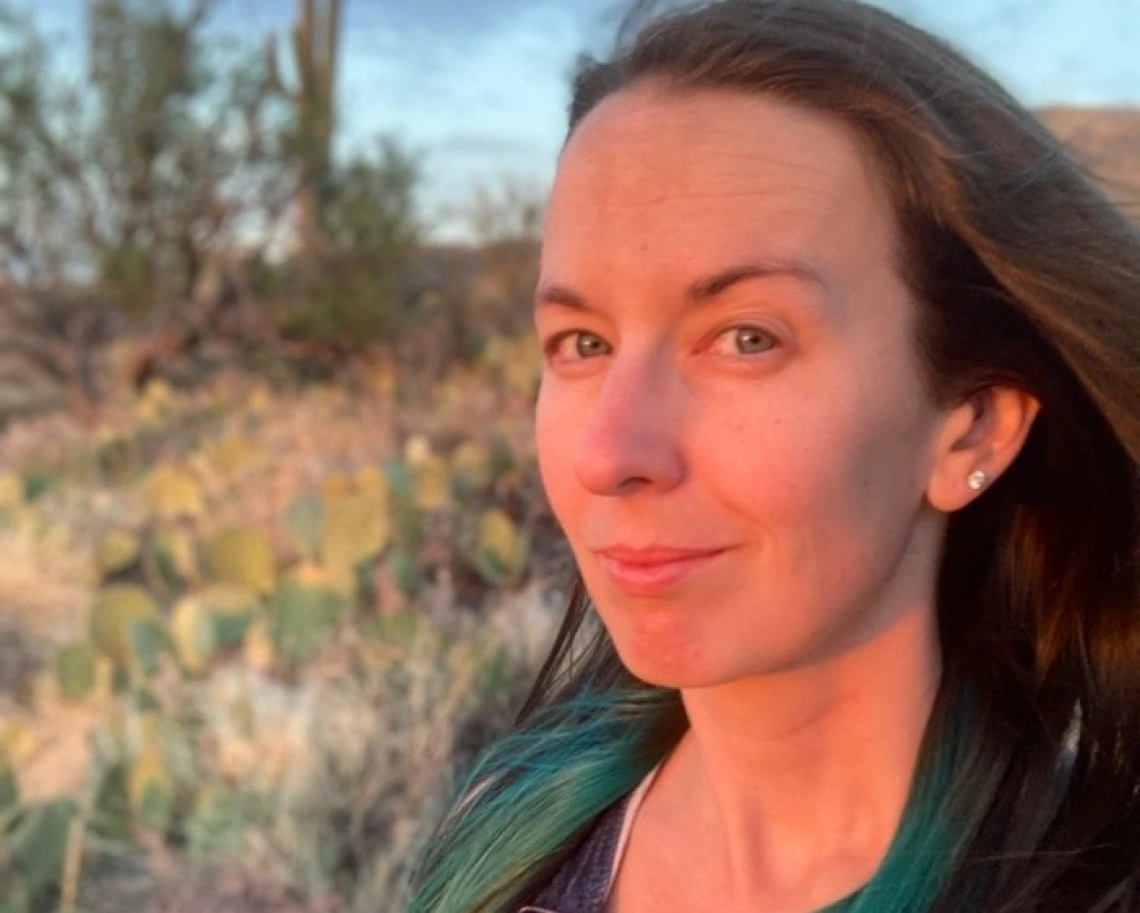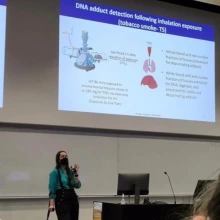Postdoctoral Research Spotlight: Sarrah Hannon

Sarrah Hannon is a first-year postdoctoral researcher in Dr. Xinxin Ding's lab. She received her PhD in Pharmacology and Toxicology with a minor in Bioinformatics and Human Disease from the University of Arizona in 2024. Before this, they earned an MS in Biomedical Forensic Science and two BS degrees in Forensic and Investigative Science and Chemistry. Sarrah worked as a forensic toxicologist in private and government labs for approximately 10 years, earning her board certification as a diplomate from the American Board of Forensic Toxicology in 2016.
In 2024, Sarrah had the opportunity to attend the 2024 18th International Congress on Combustion Byproducts in Durham, North Carolina. While at the conference, they heard about research on the compounds expected from different types of wildfires and structural fires and biological changes observed in firefighters from single versus persistent fires. She also presented her studies on naphthalene, a major component in fire smoke, and its effect on firefighters and tobacco smokers. Representatives from both the EPA and NIOSH approached Sarrah at the conference to further discuss their work and its impact on the study of fire smoke as a Class 1 carcinogen.
Sarrah’s interests include studying the effects of naphthalene exposure in firefighters and studying her rare chronic illnesses including Ehlers Danlos Syndrome, Postural Orthostatic Tachycardia Syndrome, and others. Below, she gives us a peek into her research focus and some advice for current and future pharmacy students.
Q&A
Can you tell us more about your research, especially how it relates to all the devastating fires in California?

- I study the potential for the metabolites of naphthalene, a major component in fire smoke, to bind to DNA and cause damage to it through the formation of adducts. Naphthalene has been shown to cause formation of tumors in mice and rats, but there is no direct evidence of its carcinogenicity in humans yet. While previous research in this area has been able to show DNA adducts form with naphthalene metabolites in vitro (in test tubes) and ex vivo (in skin of mice), I’ve been able to show that they form in vivo in mice and humans after exposure to cigarette smoke, naphthalene, and fire smoke. This sort of test could be important for understanding cancer in firefighters, risk assessment in firefighters in prolonged fire exposures (such as the CA wildfires) and potential pharmacological targets for prevention of this DNA damage (through prevention of the formation of these metabolites) in prolonged situations.
How do you see this research progressing?
- At this time, I am developing the synthesis of standards to quantitatively measure these adducts in biological specimens. Quantitative values will be helpful to compare the amount of adducts in different biological compartments which will lend information about the generation of these metabolites and whether they happen primarily in the lungs or liver. Comparison blood levels of adducts to lung levels in the mice, could allow us to predict lung damage in firefighters with just the blood levels, improving risk assessment.
As an alumna, what is some advice that you have for students?
- The best thing you can do for yourself is figure out how you learn and work best and advocate for those avenues as much as possible in both the classroom and the laboratory if you’re doing research. You are the best person to figure that out for yourself and the one who knows your needs best. Put your foot down and make sure you’re getting what you need. Also, it’s never too late to come back to school.
How did your degree and career path in forensic toxicology lead you to pursue a PhD?
- I am somebody who lives with a lot of chronic illnesses and chronic pain from a number of surgical procedures on my brain and spine as well as many other joints. I am also somebody who has been abused by the healthcare system through my treatment as someone with rare diseases that took a long time to diagnose and someone who has chronic pain during the opioid epidemic. I have unique experience as someone who requires pain medication but has also worked in forensic toxicology fields, such as pain management drug testing. I understand all sides of this area and one day decided that I needed to do more for people like me aside from the rare disease advocacy work I do. I decided to come back for my PhD so I could apply my unique experiences to researching my rare diseases and advocating for myself and my friends that way, too.
Besides being a post-doc in Dr. Ding’s lab, what other responsibilities do you have at RKCCOP?

- I contribute two lectures to the General Systems Toxicology course (PCOL535) in the College of Pharmacy, coordinated by Dr. Nathan Cherrington. My topics are Mechanisms of Toxicity and Forensic Toxicology. I’ve been contributing to that course since before I finished my PhD (in 2021). I also teach a 3-credit undergraduate course, Introduction to Forensic Toxicology. This spring is the first offering of this course which I proposed, wrote, and am now teaching all on my own. I serve as a mentor for undergraduate students in BSPS and MCB programs. My first undergraduate student, Ines Studer (BSPS 2024), is now a research technician in our lab.
What is your favorite part of teaching that course?
- I have really been enjoying seeing how engaged my students are in the material. They are contributing to important ethical conversations surrounding the practice of forensic science and forensic toxicology, and the many ethical dilemmas the justice system presents us. It’s neat to watch students who previously had a more naïve interest in forensics (from media, fiction, documentaries, etc.) develop a more scientific interest in it.
What’s next for you?
- I plan to develop my publication profile as a postdoctoral researcher, after which I plan to apply for assistant professorship here at the University of Arizona. I’d like to teach and start my own lab as an independent researcher, focusing on the ways that environmental contaminants, p450 variants, and other toxicological factors can affect and influence human disease.

